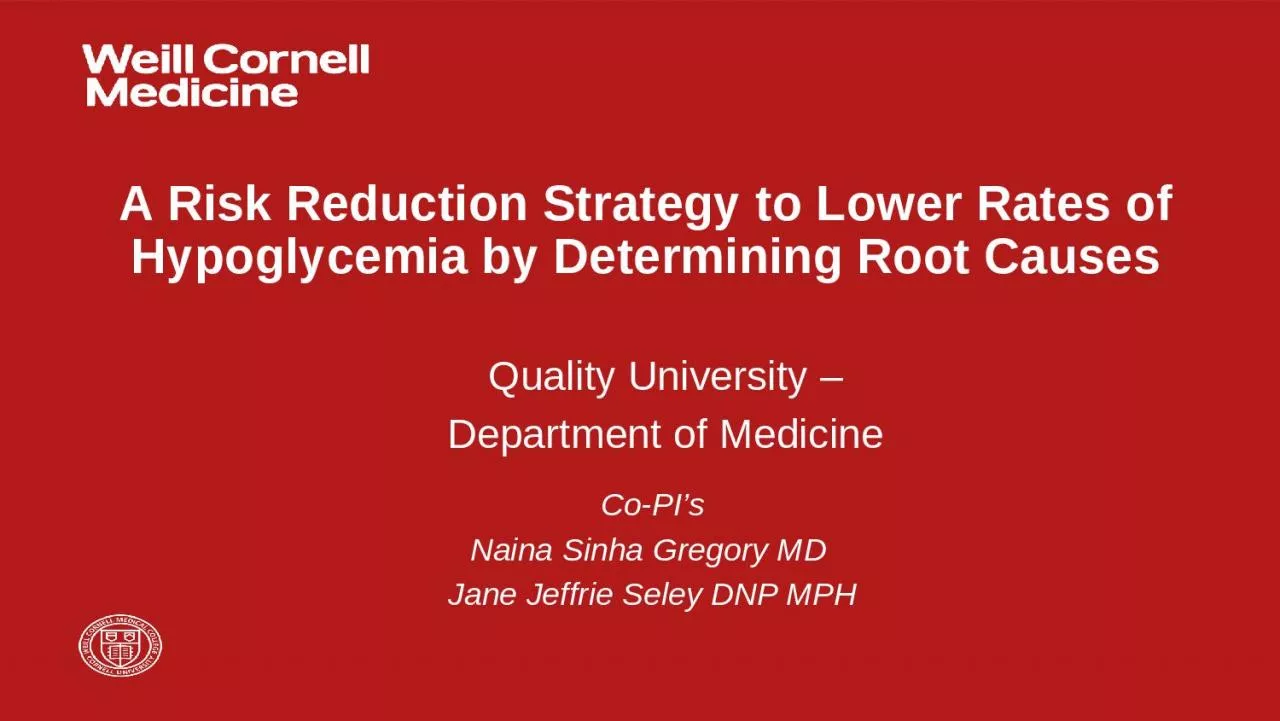

Hypoglycemia by Determining Root Causes Quality University Department of Medicine CoPIs Naina Sinha Gregory MD J ane Jeffrie Seley DNP MPH Jane Jeffrie Seley DNP MSN MPH GNP BCADM CDE CDTC ID: 999217
Download Presentation The PPT/PDF document "A Risk Reduction Strategy to Lower Rates..." is the property of its rightful owner. Permission is granted to download and print the materials on this web site for personal, non-commercial use only, and to display it on your personal computer provided you do not modify the materials and that you retain all copyright notices contained in the materials. By downloading content from our website, you accept the terms of this agreement.
1. A Risk Reduction Strategy to Lower Rates ofHypoglycemia by Determining Root CausesQuality University –Department of MedicineCo-PI’sNaina Sinha Gregory MD Jane Jeffrie Seley DNP MPH
2. Jane Jeffrie SeleyDNP, MSN, MPH, GNP, BC-ADM, CDE, CDTCFAADE, FAANProgram Manager & Diabetes NPInpatient Glycemic Control ProgramNewYork-Presbyterian/Weill Cornell Medicine New York, NY
3. Disclosure to ParticipantsConflict of Interest (COI) and Financial Relationship Disclosures:Jane Jeffrie Seley: No relevant COI/Financial Relationship to disclose
4. BackgroundWhat inspired our study…Adverse Drug Events (ADEs): Most common cause of inpatient complicationsRepresent 1/3 of hospital acquired conditionsIncreases both cost & length of stayINSULIN IS #1 DRUG ERROR
5. Background (Cont.)Insulin & other anti-hyperglycemic agents: 57% of Adverse Drug Events50% of hypoglycemic events (BG<70 mg/dL) and up to 80% of severe hypoglycemic events (BG<40 mg/dL) are preventableMost powerful predictor for hypoglycemic event is a prior hypoglycemic event during the same stay
6. PDSAProject Goal #1: PDSA CyclePlanDoStudyAct
7. PDSAProject Goal #2: PDSA CyclePlanDoStudyAct
8. Phase 1:InterventionRN Survey
9. RN Survey Part 1What do you think are the reasons why patients have hypoglycemia in the hospital?
10. RN Survey Part 2: UCSD DataCircle all of the reasons listed that may contribute to patients having hypoglycemia in the hospitalPoor Nutrition (poor appetite, nausea or vomiting)NPO for a procedure or testInterruption in Nutrition (e.g. Tube feeds or TPN being held)Incorrect dose of Insulin:Basal insulin (NPH, glargine) Bolus (correction) or mealtime Insulin (aspart)Failure to adequately treat prior hypoglycemia eventImpaired renal and/or hepatic function
11.
12. Created Electronic Health Record Survey Tool
13. Causes of Hypoglycemia IdentifiedUsing EHR Survey Tool vs Chart ReviewRN DataMD Data
14. Phase 2:Educational InterventionReducing Hypoglycemiaby Targeting a Root Cause:Too Much Basal Insulin
15. NYP/WC Insulin Dose Adjustment Guidelines for Prescribers Dose Adjustments Based on Blood GlucoseBG (mg/dL)Dose Adjustment < 50 Decrease by 50%50 – 69Decrease by 20%70 – 99Decrease by 10%100 – 180No Changes181 – 250Increase by 10%> 250 Increase by 20%
16. Results
17. p<.001 p<.001
18.
19. Lessons LearnedTop 2 modifiable causes of hypoglycemia (nutrition and insulin) were identified by RN survey & confirmed by MD chart reviewTargeted educational intervention addressing safe & effective insulin dosing resulted in significant decrease in hypoglycemia and recurrent hypoglycemia Decrease in hypoglycemia was associated with improvement in glycemic control (BG 70-180mg/dL) & DECREASE IN HYPERGLYCEMIA
20. Future DirectionsOngoing house-wide RN & prescriber education to heighten awareness of root causes of hypoglycemia to inform & promote prevention strategiesPromoting discussions between RNs & prescribers to address each episode of hypoglycemia in real-time
21. Future Directions (Continued)Launch new educational intervention targeting interruptions in nutrition:Second most common cause of hypoglycemiaInclude recommendations for insulin adjustments in education plan for prescribers: Updated Pocket Card
22. Acknowledgements Medicine Floors – 5 Central and 5 NorthAsmin Brown DNP RN (5C) & Natalie Mohammed MSN RN (5N), Patient Care Directors… With Gratitude to the entire Nursing Staff !!Division of Endocrinology, Diabetes & MetabolismSona Shah MD & Jenny Ukena MD, 2016 2nd Year Endocrine FellowsInformation TechnologyMatt Fred MD, IT Physician LiaisonHealthcare Policy & ResearchElizabeth Mauer MS, Research BiostatisticianQuDOM: Quality University, Weil Cornell Department of Medicine Robert Kim MD & Jennifer Lee MDSavira Dargar MS, Research Project Manager
23. Selected ReferencesCobaugh, D. J., Maynard, G., Cooper, L., Kienle, P. C., Vigersky, R., Childers, D., ... & Blum, F. (2013). Enhancing insulin-use safety in hospitals: practical recommendations from an ASHP Foundation expert consensus panel. American Journal of Health-System Pharmacy, 70(16), 1404-1413.Cruz, P., Blackburn, M. C., & Tobin, G. S. (2017). A Systematic Approach for the Prevention and Reduction of Hypoglycemia in Hospitalized Patients. Current diabetes reports, 17(11), 117.Kulasa, K., & Juang, P. (2017). How Low Can You Go? Reducing Rates of Hypoglycemia in the Non-critical Care Hospital Setting. Current diabetes reports, 17(9), 74.Milligan, P. E., Bocox, M. C., Pratt, E., Hoehner, C. M., Krettek, J. E., & Dunagan, W. C. (2015). Multifaceted approach to reducing occurrence of severe hypoglycemia in a large healthcare system. American Journal of Health-System Pharmacy, 72(19), 1631-1641.Sinha Gregory, N., Seley, J. J., Ukena, J., Shah, S., Fred, M. R., Dargar, S. K., ... & Kim, R. J. (2018). Decreased Rates of Inpatient Hypoglycemia Following Implementation of an Automated Tool in the Electronic Medical Record for Identifying Root Causes. Journal of diabetes science and technology, 12(1), 63-68.Sinha Gregory, N., Seley, J. J., Gerber, L. M., Tang, C., & Brillon, D. (2016). Decreased rates of hypoglycemia following implementation of a comprehensive computerized insulin order set and titration algorithm in the inpatient setting. Hospital Practice, 44(5), 260-265.The Glycemic Control Implementation Guide: Improving glycemic control, preventing hypoglycemia and optimizing care of the inpa- tient with hyperglycemia and diabetes: Society of Hospital Medicine; 2015 Available from: http://tools. hospitalmedicine.org/resource_rooms/imp_guides/GC/GC_ Workbook.pdf.
24.